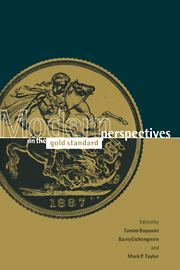Book contents
- Frontmatter
- Contents
- List of figures
- List of tables
- Notes on the contributors
- I Introduction
- 1 Modern perspectives on the gold standard: introduction
- 2 Unit roots, shocks and VARs and their place in history: an introductory guide
- II Operation of the gold standard
- III Adjustment mechanisms
- IV Monetary issues
- V Exchange rate behavior
- VI Conclusions
- Index
2 - Unit roots, shocks and VARs and their place in history: an introductory guide
Published online by Cambridge University Press: 05 November 2011
- Frontmatter
- Contents
- List of figures
- List of tables
- Notes on the contributors
- I Introduction
- 1 Modern perspectives on the gold standard: introduction
- 2 Unit roots, shocks and VARs and their place in history: an introductory guide
- II Operation of the gold standard
- III Adjustment mechanisms
- IV Monetary issues
- V Exchange rate behavior
- VI Conclusions
- Index
Summary
Introduction
In this chapter we develop, within a common framework, the econometric techniques used in many of the subsequent chapters. We begin by analyzing a fundamental problem in much historical empirical work, that of separating an observed time series into trend and cyclical components. This leads naturally on to investigating the underlying stochastic processes that generate economic time series and to discriminating between them, in particular between processes that contain a unit root and those that are generated as stationary fluctuations around a deterministic trend.
We then move to a multivariate setting and introduce the vector autoregression (VAR) framework, within which the concept of Granger causality fits naturally. Various extensions to the VAR framework, known as structural VARs, are used in this volume; these are also discussed. Nonstationarity must also be tackled within a multivariate setting and this enables the concept of cointegration – the presence of common trends within a group of time series – to be introduced into the analysis. These issues are the subject of the penultimate section, before some comments conclude the chapter.
Trends and cycles in macroeconomic time series
Researchers studying the growth and cyclical behavior of industrialized economies are immediately faced with the problem of separating out cyclical fluctuations from the longer-term trend, or secular, movements.
Information
- Type
- Chapter
- Information
- Modern Perspectives on the Gold Standard , pp. 17 - 52Publisher: Cambridge University PressPrint publication year: 1997
